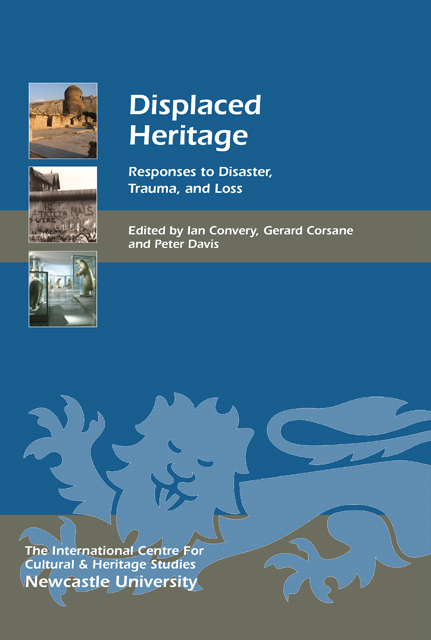Book contents
- Frontmatter
- Contents
- List of Illustrations
- Acknowledgments
- List of Abbreviations
- Preface
- Introduction
- Displaced Heritage: Histories and Tourism
- Displaced Heritage: Trauma, Confinement and Loss
- Displaced Heritage: Lived Realities, Local Experiences
- Displaced Natural Heritage
- Endpiece
- List of Contributors
- Index
- Heritage Matters
20 - Cultural Heritage and Animal Disease: The Watchtree Memorial Stone
Published online by Cambridge University Press: 24 February 2023
- Frontmatter
- Contents
- List of Illustrations
- Acknowledgments
- List of Abbreviations
- Preface
- Introduction
- Displaced Heritage: Histories and Tourism
- Displaced Heritage: Trauma, Confinement and Loss
- Displaced Heritage: Lived Realities, Local Experiences
- Displaced Natural Heritage
- Endpiece
- List of Contributors
- Index
- Heritage Matters
Summary
In the far north-west of England are two immense Scottish stones. One is in a dark underpass in Carlisle where dim light catches the inscription on its polished surface: the vitriolic interdiction of a 16th-century archbishop and his mighty curse upon the Border Reivers. Put there to mark the Millennium, this seven-foot monolith was conceived by a Carlisle-born artist and carved in Galloway. The other stone stands some seven miles away to the west at a place now called Watchtree. This squat boulder, carried by ice across the Solway during the last glaciation, lay deep underground until it was unearthed during the Foot and Mouth epidemic of 2001. It is now a memorial and bears a small bronze plaque (see Fig 20.1). Both stones commemorate times of grief and destruction and are intended to use art and nature respectively to place those sorrows firmly in the past. Yet both continue to attract controversy and bitterness.
In May 2013, the warden of Watchtree Nature Reserve gave a sigh of resignation as he told us that there are still visitors who come to remember – more in anger than sorrow – the events of 2001. That was the year when Great Orton airfield, as Watchtree was then known, became a place of slaughter and burial for an estimated half a million animals. The warden told us that he had recently been confronted by an enraged woman who took issue with an information board that referred to animals being ‘laid to rest’: ‘They were not laid to rest’, she insisted, ‘they were murdered!’ Others come as far as the entrance and cannot go any further; their memories, or the unconscious feelings they arouse, are too powerful to overcome. He told us that these visitors tend to come in the spring, and that he recognises them immediately. There is something in the way that they approach the visitor centre. What is it he sees? Is it dread, anger, or a desire to make sense of the past? What brings one man to the memorial stone where he stands for over an hour, a book in his hand, performing a ritual that only he understands or gains comfort from?
- Type
- Chapter
- Information
- Displaced HeritageResponses to Disaster, Trauma, and Loss, pp. 225 - 234Publisher: Boydell & BrewerPrint publication year: 2014



